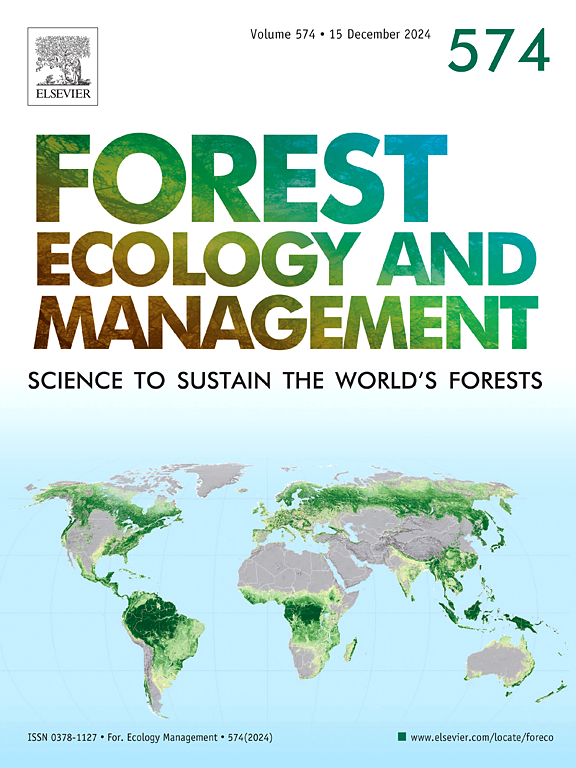云杉树皮甲虫爆发的兴衰——殖民化密度和繁殖成功的重要性
IF 3.7
2区 农林科学
Q1 FORESTRY
引用次数: 0
摘要
杀死树木的树皮甲虫是针叶林的重要干扰因子。我们研究了树皮甲虫在殖民地树木中的表现是否会影响爆发的进展。在瑞典南部的一场暴风雨引发的整个爆发期间,对欧亚云杉树皮甲虫Ips typographus殖民的树木进行了采样。这项研究是在九个没有进行卫生切割的风暴缺口进行的。在7年的时间里,从秋天采集的被风暴砍伐和立木的树皮样本中,记录了印字蝽的殖民化密度(母体通道密度)和繁殖成功率(每个母亲的后代),以及竞争对手和敌人的密度。年殖民密度在风暴砍伐的树木(68 - 103画廊/ m2)比立木(218 - 717画廊/ m2)低得多。对于立木,最低的定殖密度发生在爆发的头两年,定殖密度与树径呈正相关。在被风暴砍伐的树木中,甲虫的繁殖成功率(每个母亲9.4 - 9.6个女儿)高于直立树木(每个母亲0.4 - 5.7个女儿)。在立木中,最高的值出现在暴发的头两年。繁殖成功率与定殖密度(负相关)、树径(正相关)、寄生蜂密度(高密度时负相关)和攻击年份(负相关)显著相关。殖民化密度的影响最大。我们的研究结果证明了以增加树木活力和最小化风暴砍伐风险的方式管理云杉林的重要性。及时卫生地修剪被风暴砍伐的和低活力的立木,可以减少爆发的风险。本文章由计算机程序翻译,如有差异,请以英文原文为准。
Rise and fall of a spruce bark beetle outbreak – Importance of colonisation density and reproductive success
Tree-killing bark beetles are an important disturbance factor in conifer forests. We studied if bark beetle performance in colonised trees may influence outbreak progression. Trees colonised by the Eurasian spruce bark beetle Ips typographus were sampled during an entire outbreak triggered by a storm-felling in southern Sweden. The study was conducted at nine storm gaps where no sanitation cuttings were done. Colonisation density (maternal gallery density) and reproductive success (daughters per mother) of I. typographus, and densities of competitors and enemies, were recorded from bark samples collected in the autumn from colonised storm-felled and standing trees during seven years. Yearly colonisation densities were much lower in storm-felled (68 – 103 galleries per m2) than in standing trees (218 – 717 galleries per m2). For standing trees the lowest colonisation densities occurred in the first two years of the outbreak and colonisation density was positively related to tree diameter. Beetle reproductive success was higher in storm-felled (9.4 – 9.6 daughters per mother) than in standing trees (0.4 – 5.7 daughters per mother). In standing trees the highest values occurred in the first two years of the outbreak. Reproductive success was significantly related to colonisation density (negatively), tree diameter (positively), parasitoid density (negatively at high densities) and attack year (negatively). Colonisation density had the largest effect. Our results demonstrate the importance of managing spruce forest in a way that increases tree vitality and minimises the risk for storm-fellings. Timely sanitation cuttings of colonised storm-felled and low-vitality standing trees may reduce the risk for outbreak initiations.
求助全文
通过发布文献求助,成功后即可免费获取论文全文。
去求助
来源期刊

Forest Ecology and Management
农林科学-林学
CiteScore
7.50
自引率
10.80%
发文量
665
审稿时长
39 days
期刊介绍:
Forest Ecology and Management publishes scientific articles linking forest ecology with forest management, focusing on the application of biological, ecological and social knowledge to the management and conservation of plantations and natural forests. The scope of the journal includes all forest ecosystems of the world.
A peer-review process ensures the quality and international interest of the manuscripts accepted for publication. The journal encourages communication between scientists in disparate fields who share a common interest in ecology and forest management, bridging the gap between research workers and forest managers.
We encourage submission of papers that will have the strongest interest and value to the Journal''s international readership. Some key features of papers with strong interest include:
1. Clear connections between the ecology and management of forests;
2. Novel ideas or approaches to important challenges in forest ecology and management;
3. Studies that address a population of interest beyond the scale of single research sites, Three key points in the design of forest experiments, Forest Ecology and Management 255 (2008) 2022-2023);
4. Review Articles on timely, important topics. Authors are welcome to contact one of the editors to discuss the suitability of a potential review manuscript.
The Journal encourages proposals for special issues examining important areas of forest ecology and management. Potential guest editors should contact any of the Editors to begin discussions about topics, potential papers, and other details.
 求助内容:
求助内容: 应助结果提醒方式:
应助结果提醒方式:


